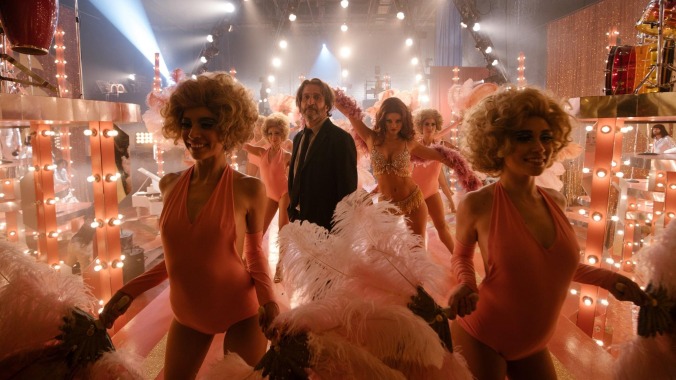In Bardo, False Chronicle Of A Handful Of Truths, Alejandro G. Iñárritu blurs fantasy and reality
The Mexican filmmaker's thinly fictionalized odyssey follows an uneven, sometimes self-indulgent path

They say write what you know, and filmmakers have been mining their personal lives for inspiration since the start of the art form. Alejandro G. Iñárritu is the latest to craft a thinly fictionalized film from his own life and experiences with Bardo, False Chronicle Of A Handful Of Truths. Are such autofiction narratives merely a trend, or have they become a genre into themselves? How do you distinguish one amongst this plethora of films?
For Iñárritu’s Bardo, we can start by recognizing it as an absurd comedy, with allusions to Federico Fellini’s 8½. Instead of a film director, the stand-in for Iñárritu is Silverio Gama (Daniel Giménez Cacho), a world-renowned journalist and documentarian going through a rather intense midlife crisis. After spending the last two decades away from his native Mexico, he’s back to receive a prestigious award, to reconnect with family and friends, and of course to examine why he left (and what he lost) by leaving. In tow comes his wife Lucía (Griselda Siciliani), his twentysomething daughter Camila (Ximena Lamadrid) and teenage son Lorenzo (Íker Sánchez Solano), each grappling with their own crises. Lucía, like Silverio, is still mourning their son who died as an infant. Camila and Lorenzo, also like their dad, are feeling the push-pull of old country vs. new country after growing up in America, and losing a sense of belonging to Mexico.
Iñárritu throws a lot at the audience. This is a movie that imagines a world in which Amazon bought the Mexican state of Baja. A world that imagines people dropping to the ground as they are walking from the weight of history and politics. It’s a world where sometimes our hero glides through Mexico City and at other times flies through the desert. He’s at the Mexican-American border in scenes that have a documentary feel as Silverio records the testimony of immigrants crossing. Yet somehow suddenly this seemingly real world disappears and we are in a fantastical yarn about religious saints protecting the same immigrants. Some characters speak without moving their lips in a jarring visual stunt that’s supposed to say something about their ability to communicate. In Bardo everyone is a fabulous dancer and a verbose orator. Characters yell at each other delivering long monologues that act as theses on life. Historical battles are recreated, and fanciful theoretical fights are won and lost. Bardo demands that we go along with all these flights of fantasy and imagination. It’s a lot, and it’s exhausting. Yet at times invigorating.
The film first comes alive when Silverio visits a soundstage to record a TV interview. As Darius Khondji’s camera follows Giménez Cacho, we discover all that concerns him, stunningly rendered in monitors that fill the set. These long roving tracking shots are repeated multiple times to showcase Silverio’s innermost thoughts. And it’s in those times that Iñárritu’s vision comes into sharp focus and the audience is both entertained and moved. In those instances Bardo becomes something special, even necessary. In conversations with his wife and his parents as he roams houses, deserts, and cities, Iñárritu is able to render a whole life in a few arresting displays.
Unfortunately, when Iñárritu ventures from the personal into the political, he loses his touch. Paralyzed by guilt for being a lucky immigrant with easy access to the world, he’s unable to formulate a narrative except for the very rudimentary admittance that he’s aware of his privilege. The arguments he presents are inert and facile, especially in comparison to his grand visual ambition, or even to his sweet and heartbreaking reckoning with the loss of an infant son. There in particular, he’s able to mine comedy and pathos and give the audience visuals and narratives they have not encountered before. Bardo has space to show a baby refusing to be born—and appearing later out of his mother’s vagina during a sex scene. Some audiences may find this subplot ridiculous, and it is—but it’s also moving and full of heart.
Even when one thinks he’s exhausted all ideas, Iñárritu keeps pushing and comes up with an ingenious setup or a gorgeous visual motif. Later in the film we are treated to a funny episode where Silverio and his children argue with a U.S. border official who refuses to acknowledge that the U.S. is their home. Everyone who has passed through an airport as a “foreigner” entering the U.S. recognizes the ludicrous inventiveness of that scene. No one would fight an immigration official because they hold the keys to making your life miserable. Yet we all want to. We want to be treated better, to be welcomed with open arms. Just like Silverio. But the scene comes so late in the movie, after the point has been repeated several times, that it loses its impact. More egregiously, it loses its satiric resonance. We can’t laugh at a joke when we know the punchline, no matter how clever it is.
In the central role Giménez Cacho is burdened with a tricky responsibility. Silverio is an observer who doesn’t say much. He’s not called upon to emotionally carry the narrative, which limits his ability to connect with the audience. He has an easy physicality that makes him look alluring at the center of the frame whether he’s dancing, walking or listening. Yet the character remains a bystander in his own story.
Dense and laborious, Bardo sometimes feels like an endurance test. Its moments of visual brilliance carry it far. Just not far enough to become essential viewing. Iñárritu has a lot to say, most of it quite astute. Yet he couldn’t make all that disturbs him come together in a digestible way.